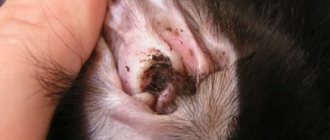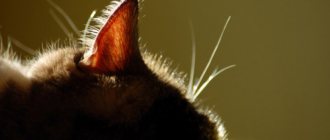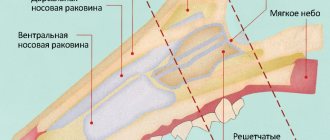If blackness appears in the ears of cats, this indicates poor ear hygiene or is a symptom of ear mites. With otodectosis, the disease has several stages of progression and is accompanied by severe itching, the appearance of crusts, and brown-black discharge. When a cat's ears turn black, the owner should take the pet to a veterinarian, who will diagnose and prescribe treatment.
According to veterinarians, ear parasites affect young cats and kittens whose immune systems are weakened.
Why does plaque appear?
Lack of hygiene
Earwax in cats, like in humans, has a protective function against the entry of pathogenic fungi, bacteria and small insects into the ear canal. It also serves as a lubricant for the inner canals of the ear. The auricle itself secretes a small amount of sebum. If a lot of wax and fat accumulate in the ears, dirt and dust stick to them. Because of this, a black coating is formed, especially noticeable in breeds with large ears and open ears - American Curl, Sphynx, Rex, Havanese, Javanese, Siamese, Oriental Shorthair cats.
Ear mite
This parasite can live in various animals.
The causative agent of otodectosis is the microscopic oribatid mite Otodectes. It parasitizes not only cats, but also dogs, rodents, and ferrets. Therefore, infection of a domestic cat is possible from other pets visiting the street. A sick cat can also infect all the pets living in the room with it. Most often it develops in animals with weak immunity and lack of hygiene. The parasite is very rare in humans and causes otitis externa.
Possible complications
Ear cleaning is a must.
Itching can cause a lot of inconvenience for your pet, but, unfortunately, this is only the beginning of the problem. There are many more reasons why it is important to pay attention to this problem in time. Scratches can lead to infection. In extreme situations, these infections can lead to hearing loss and balance problems as a result of the ear canal being blocked.
If infected wounds are left untreated, your pet may continue to have hearing problems, so it is important to see a veterinarian as soon as possible if you notice a wound.
Mites cause irritation and inflammation; infection can spread to both the external and internal auditory canals. This can lead to more serious skin or ear infections. As a result of the accumulation of characteristic secretions, complete closure of the ear canal may occur, which will lead to partial or complete hearing loss. Advanced inflammatory processes worsen, penetrating deeper and deeper, causing suffering to the animal.
When to sound the alarm?
If black spots and spots in a cat's ears are caused by poor hygiene, the animal remains calm and playful, and has a good appetite. The ear itself is white, not inflamed. Anxiety is caused by brown discharge, which is a waste product of the tick. Dangerous symptoms at different stages are shown in the table:
| Stage | Symptoms |
| Initial | The mite penetrates under the skin, irritating the nerve endings |
| The ear is very itchy and painful | |
| Redness and swelling of the external auditory canal | |
| Brown plaque in the ears that resembles asphalt | |
| Unpleasant smell | |
| Average | Dark crusts form and plugs form |
| Severe itching, the cat shakes its head and screams | |
| The appearance of scratches and wounds | |
| The auricle is lowered, the animal’s head is leaning towards the side of the affected ear | |
| Anxiety, aggression, poor sleep and appetite | |
| The mite spreads to the natural bald patches near the ear and muzzle, causing it to swell | |
| Perforation of the eardrum and introduction of mites into the inner ear | |
| Heavy | Dark plaque is visible not only inside the organ, but also on the tips of the ears |
| Parasites invade the brain, causing inflammation | |
| Sick animals meow loudly in pain | |
| Refusal to eat, apathy, seizures | |
| Possible death |
Natural causes
Brownish discharge is practically the only type of ear discharge that can appear for physiological reasons. This phenomenon is due to increased activity of the sulfur glands: during the hot season, with a sharp change in climatic conditions or with serious physical activity. As a result, body temperature and sweating increase, the cerumen glands begin to produce excess secretion (wax), and a brown substance appears, which is earwax with a softened consistency. This is a normal physiological process that gives no cause for alarm.
Diagnostic measures
The animal's hearing organs are subject to a thorough examination by a doctor.
To find out why the ear turns black, the veterinarian performs an external examination. A specific crust, scratching and greasy black discharge help in making a diagnosis. To confirm otodectosis, plaque scraping and examination under a microscope are performed. The procedure takes little time, is painless and non-traumatic. An otoscopy is also performed to find out how much the inner ear is affected.
Diagnostics
To establish an accurate diagnosis and choose treatment tactics, the otolaryngologist conducts a comprehensive examination of the patient. When evaluating the allocated secret, the following characteristics are taken into account:
- color;
- smell;
- volume;
- presence of additional symptoms.
Instrumental methods for examining pathologies:
- CT scan. It is carried out to exclude injuries to the skull bones.
- Otoscopy. With its help, you can see the development of the inflammatory process.
- Microscopy. Needed for a more detailed inspection of damaged areas.
How to treat?
Veterinarians recommend cleaning your pet’s ears no more than 1-2 times a week, since daily hygiene procedures reduce the natural balance of beneficial microflora and make the cat vulnerable to pathogens.
If your cat’s ears have brown plaque and spots due to dirt, you should clean the outer part of the hearing organ with special hygiene products:
The hygiene of the external part of the pet's hearing organs can be maintained with the help of Otifri.
- "Leopard";
- "Otifri";
- "SkinMed Otik";
- "Tropiclean Dual";
- "Sani Pet";
- "Beafar Air Cleaner";
- "Trixie."
If your ears itch and hurt due to mites, you should treat them with anti-mite medications. The dosage for an adult cat and kitten is determined by a veterinarian; self-medication is prohibited. Both hearing organs should be instilled, even if infection occurs in only one. The procedure should be done with drugs such as “Bars”, “Otoferonol Gold”, “Amitrazine Plus”, “Surolan”. During the treatment period, all animals living in the premises, their sleeping places and accessories should be disinfected.
Prevention of ear diseases in animals
Treatment of a kitten at the veterinarian
Preventing the onset of disease is much easier than treating an infected animal. To keep your pet safe, have your pet's ears cleaned and checked by a veterinarian monthly. It is also recommended to deworm your kitten regularly. The likelihood of ear mite infestation increases if your kitten comes into contact with other animals that may be carriers. Therefore, try to avoid unwanted contacts. Also make it a habit to clean your home and pets' bedding twice a week to reduce the risk of infection.
Folk remedies
If for some objective reason a visit to the doctor is temporarily impossible, then traditional medicine comes to the rescue. Herbs and lotions are unlikely to be able to completely cure otodectosis, but they may well be able to alleviate the animal’s suffering until the time of visiting the veterinary clinic.
- Green tea based drops. A tablespoon of dry leaves is poured into a glass of water and left for 5-10 minutes. After cooling to a warm state, the solution is taken into a pipette and a few drops are instilled into each ear.
- Garlic has powerful antiseptic properties. In the case of ear mites, it is infused in oil for 24 hours, and then the resulting solution is instilled into the ears once a day. Olive, flaxseed, sunflower, almond and other oils are used as the basis for the tincture.
- Celandine juice is instilled into the ears in the morning and evening, two drops per ear. Freshly picked herbs are ground in a meat grinder and then squeezed in gauze to prevent any remaining leaves or stems from getting into the juice ready for use.
Associated symptoms indicating pathology
In the case when the appearance of dark dirt in the ears of an adult cat or kitten is associated with dust, in order to get rid of it for 1-2 weeks, it is enough to wipe the pet’s ears with a damp cotton pad and clean the auricle with a cotton swab. However, if after cleansing the plaque quickly accumulates again, this is a sign of the development of pathology. The table describes symptoms that occur for various reasons.
| Pathology | Characteristic symptoms | Specific signs |
| Otodectosis |
| Gradually the brown coating turns black. As the disease progresses, a lot of dark dirt appears and purulent wounds form. |
| Otitis |
| As the pathology develops, the unpleasant odor becomes more intense. In the advanced stage, the cat begins to hear poorly. |
| Sulfur plug |
| After infection enters the ear, signs of otitis media are observed. |
| Allergy |
| With allergies, unpleasant symptoms disappear or become less noticeable in the absence of contact with the allergen. |
| Fungus |
| The pet's skin becomes dry, the coat loses its shine. |
| Necrosis |
| Gradually, the cat’s condition worsens, and deformation of the auricle appears. |
Treatment options
Effective medicines to combat ear mites are insecticide-based products. The only point that needs to be taken into account is that they act specifically on living parasites, but are absolutely not effective in killing larvae. Since the incubation period of infection is 21 days, the course of therapy should last at least three weeks, covering the entire life cycle of the tick.
- Drops. Most often, the following drugs are prescribed: Tresaderm, Ivomek, Bars, Amitrazine Plus, Otoferonol Gold, Tsipam. The advantage of using Tresaderm is that the antibiotic included in its composition affects not only the adult tick, but also its eggs, and at the same time fights fungi and other infectious inflammations. The drug Ivomec can be prescribed in the form of injections and injected into the animal according to a schedule several times a month. The remaining drops from the above list tend to affect worms if they are present.
Important: so that the cat does not get nervous during instillation, the liquid must be slightly warmed up.
- Ointments (aerosols). Aversectin ointment works well in practice, which is applied to the ear with a special spatula and is well absorbed into the skin during rubbing. Amit ointment, made on the basis of amitraz and prednisolone, has a similar acaricidal effect. Disinfection of the ears is carried out twice a day for 5 days. A cotton swab is lubricated with a creamy substance and then gently rubbed into the skin. Acaromectin spray, sprayed onto the inner surface of the ear according to the attached instructions, is effective against otodectosis.
A doctor may also prescribe Stronghold, Frontline or Oridermil, but these drugs are contraindicated for use as self-medication - only on the recommendation of a veterinarian. For preventive purposes, the drug Revolution for Cats is often prescribed - It is applied to the withers using a drop method. After absorption into the skin, the active substance acts simultaneously on both ticks and fleas, if any.
The cat has black plaque in his ears. Where to go?
- Ace Ventura. Laboratory diagnostics for ectoparasites (otodectosis, etc.) 400 rubles. You can call a doctor at home. The cost depends on the distance from the clinic and varies from 1,000 to 10,000 rubles. Address: Academician Vinogradova street, 1k1, 1st floor.
- Aura Clinic. Analysis for otodectosis 200 rubles. Initial appointment 650 rubles. Address: Verkhnie Polya street, 36k1.
- Vega Clinic. Microscopy of ear contents for otodectosis 340 rubles. Appointment with a dermatologist is 1,500 rubles, a therapist is 765 rubles. Address: Marshal Katukova Street, 17k1, 2nd floor.
- Felis Veterinary Clinic. Taking scrapings for the presence of pathogenic fungi and mites (demodex, otodectosis) without the cost of examination (with materials) 200 rubles. Initial appointment is 400 rubles. Address: Udarnikov Avenue, 38 building 1, 1st floor.
- Center for Veterinary Diagnostics and Minimally Invasive Surgery TrustVet. Microscopy of skin scrapings, earwax to detect subcutaneous mites of the genera Sarcoptes, Notoedres, Demodex, Otodectes 600 rub. Appointment with a therapist costs 800 rubles. Address: Komendantsky Prospekt, 27 k1, ground floor.











